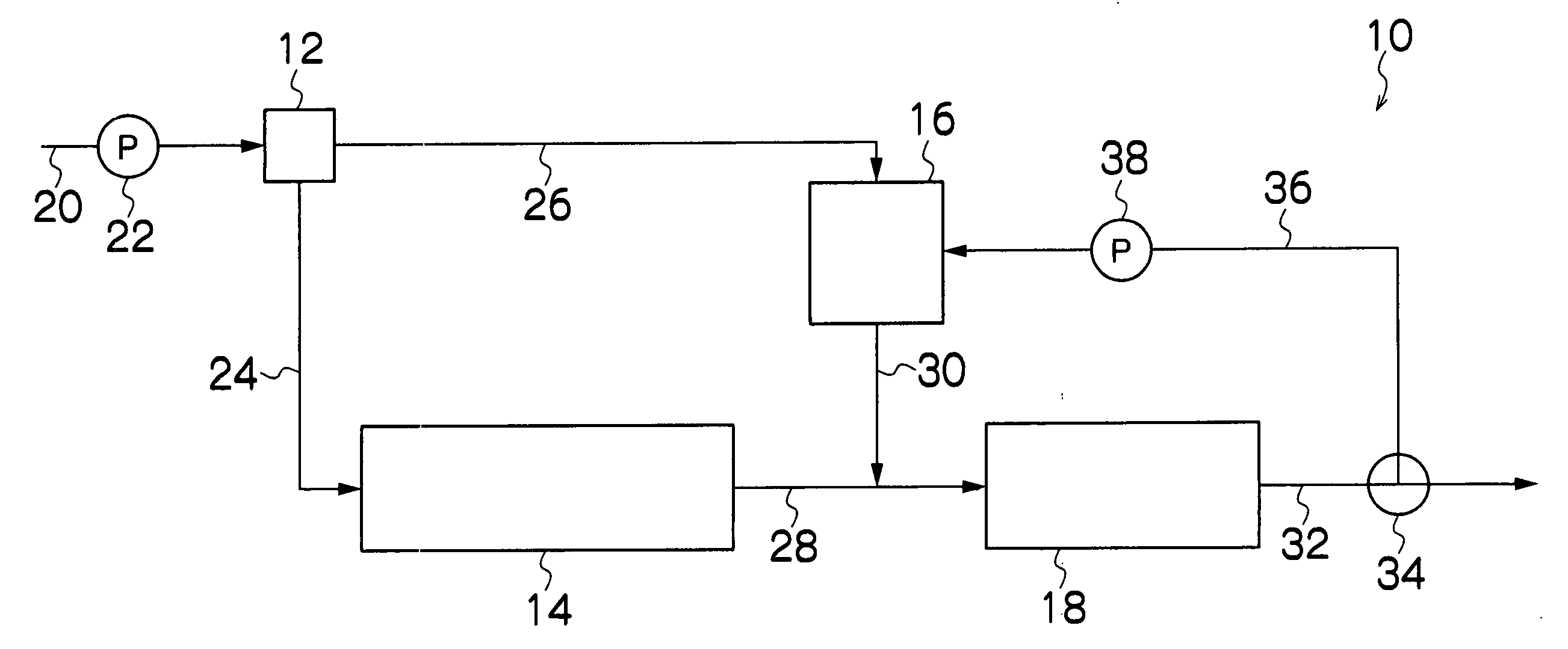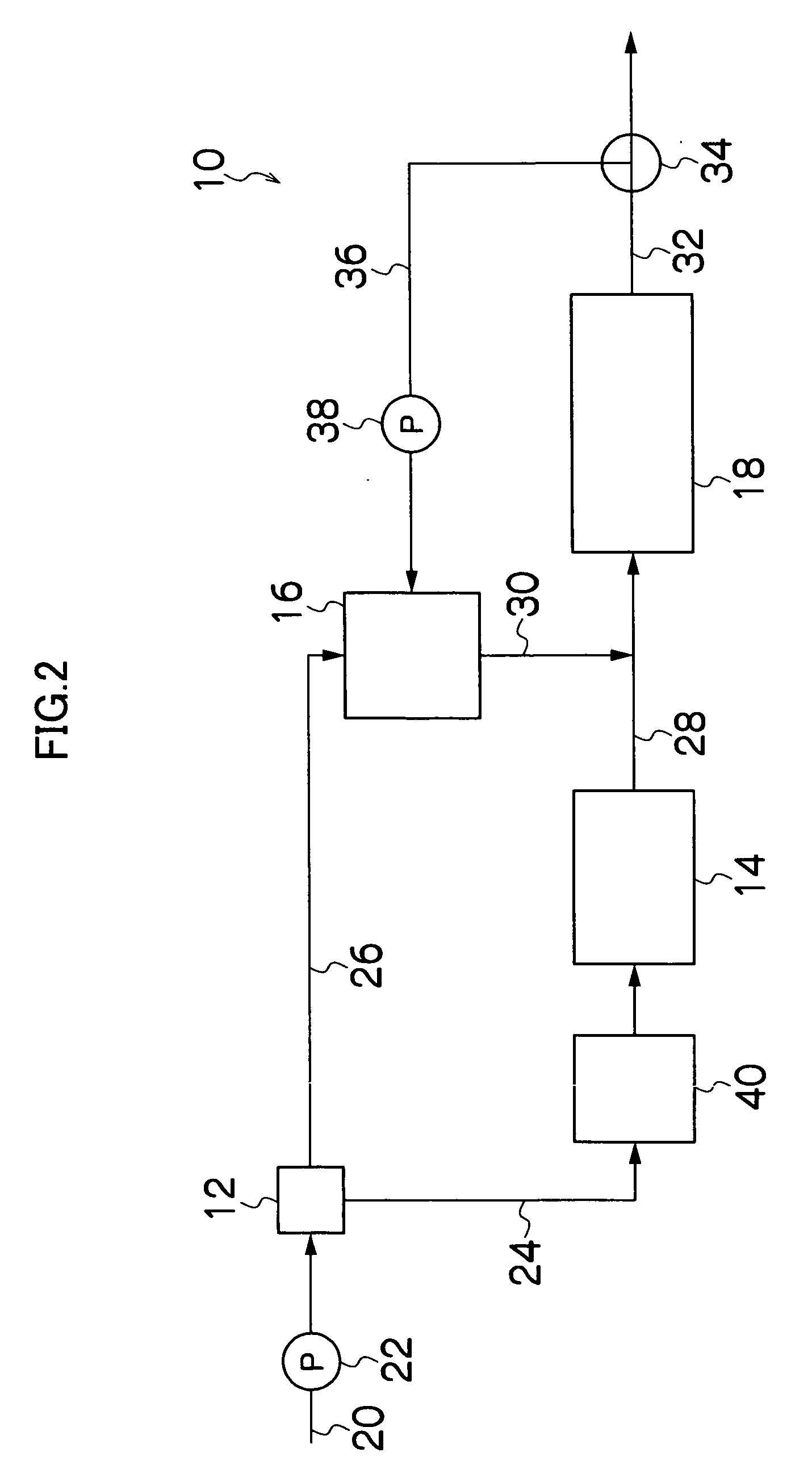Method and apparatus of removing nitrogen
a technology of nitrogen removal and nitrogen concentration, applied in the direction of chemistry apparatus and processes, biological water/sewage treatment, water/sludge/sewage treatment, etc., can solve the problem of difficult to accurately control the ratio closer to this value, and the method has a difficult problem, so as to improve the performance of anaerobic ammonium oxidation, reduce the concentration of nitrite nitrogen, and improve the effect of nitrogen removal
- Summary
- Abstract
- Description
- Claims
- Application Information
AI Technical Summary
Benefits of technology
Problems solved by technology
Method used
Image
Examples
example 1
[0062] A test wastewater treatment was performed by use of nitrogen removing apparatus 10 according to the present invention shown in FIG. 1.
(Wastewater Subjected to Test)
[0063] As the wastewater subjected to test, a diluted solution of digested sewage sludge decomposition liquid was used after its ammonium nitrogen concentration (NH4—N) was adjusted to 300 mg / L by adding ammonium sulfate as a NH4—N source. The wastewater thus adjusted had a BOD component concentration of 18 mg / L, and a nitrite (NO2) concentration and a nitrate (NO3) concentration both were 5 mg / L or less.
(Treatment Conditions)
[0064] The distribution ratio by the distributor 12: The first pipe 24 to the second pipe 26=65:35. [0065] The volume load of each of the vessels 14, 16, and 18 was determined based on wastewater concentration (NH4—N)=300 mg / L. The volume load of nitrification vessel 14 was set at 0.6 kg-N / m3 / day. Furthermore, the nitrification vessel 14 was packed with entrapping immobilization pallets,...
example 2
[0073] A test wastewater treatment was performed by use of nitrogen removing apparatus 10 according to the present invention shown in FIG. 2.
(Wastewater Subjected to Test)
[0074] As the wastewater subjected to test, a diluted solution of digested sewage sludge decomposition liquid was used after its ammonium nitrogen concentration (NH4—N) and BOD component concentration were adjusted respectively to 300 mg / L by adding ammonium sulfate as a NH4—N source, and 200 mg / L by adding sodium acetate as a BOD component source. Note that nitrite (NO2) concentration and nitrate (NO3) concentration of the wastewater thus adjusted were 5 mg / L or less.
(Treatment Conditions)
[0075] The distribution ratio by the distributor 12: The first pipe 24 to the second pipe 26=65:35. [0076] The volume load of each of the vessels 14, 16, and 18 was determined based on wastewater concentration (NH4—N)=300 mg / L. The volume load of nitrification vessel 14 was set at 0.6 kg-N / m3 per day. Furthermore, the nitri...
example 3
[0085] A test wastewater treatment was performed by use of nitrogen removing apparatus 10 according to the present invention shown in FIG. 4.
(Wastewater Subjected to Test)
[0086] The same wastewater as used in Example 1 was used.
(Treatment Conditions)
[0087] The distribution ratio by the distributor 12: The first pipe 24 to the second pipe 26=65:35. [0088] The volume load of each of the vessels 14, 16, and 18 was determined based on wastewater concentration (NH4—N)=300 mg / L. The volume load of nitrification vessel 14 was set at 0.6 kg-N / m3 / day. Furthermore, the nitrification vessel 14 was packed with entrapping immobilization pallets, which were previously heated at 60° C. for one hour, to a packing ratio of 15% by volume. [0089] The nitrogen load of the denitrification vessel 16 based on the sum (NOx—N) of nitrite nitrogen (NO2—N) and nitrate nitrogen (NO3—N) was set at 0.2 kg-N / M3 / day. The denitrification vessel 16 was packed with attaching media made of vinyl chloride so as t...
PUM
 Login to View More
Login to View More Abstract
Description
Claims
Application Information
 Login to View More
Login to View More - R&D
- Intellectual Property
- Life Sciences
- Materials
- Tech Scout
- Unparalleled Data Quality
- Higher Quality Content
- 60% Fewer Hallucinations
Browse by: Latest US Patents, China's latest patents, Technical Efficacy Thesaurus, Application Domain, Technology Topic, Popular Technical Reports.
© 2025 PatSnap. All rights reserved.Legal|Privacy policy|Modern Slavery Act Transparency Statement|Sitemap|About US| Contact US: help@patsnap.com



